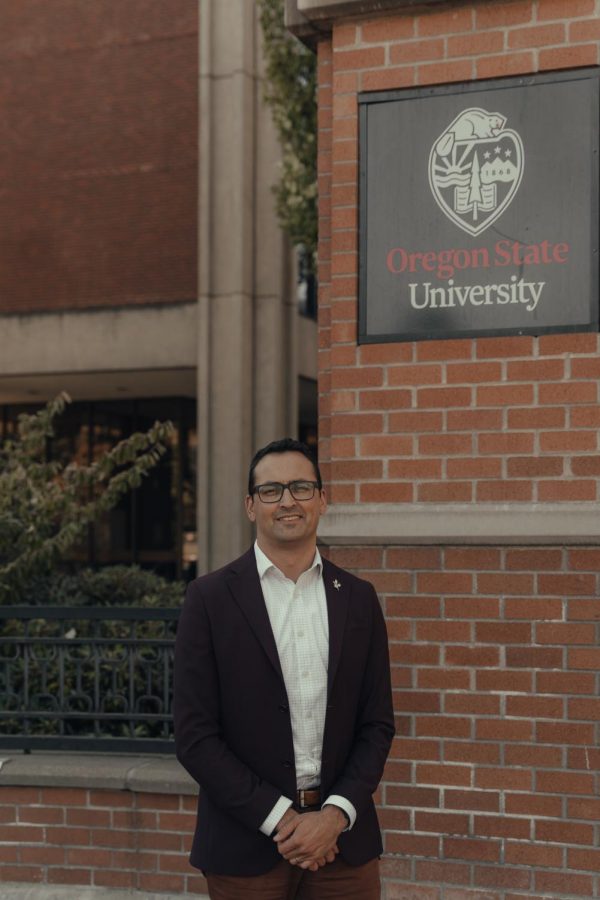Scott Vignos chosen to lead OSU inclusion and diversity office
Scott Vignos stands before an Oregon State University sign near the Kerr Administration building, where the Office of Institutional Diversity is located. Vignos has served as vice president and chief diversity officer since November 2022.
September 23, 2021
Scott Vignos, named as the new Oregon State University interim vice president and chief diversity officer, will head the Office of Institutional Diversity as of Sept. 20.
Since October 2015, Vignos has dedicated his time to the OSU community as the director of strategic initiatives and then as the assistant vice president in the OID.
Steve Clark, OSU’s vice president of University Relations and Marketing, has worked with Vignos for the past four years throughout his work on institutional diversity.
“Scott is an impressive and inspiring person and colleague,” Clark said. “Over the years and on a daily basis, he contributes not only to institutional diversity and advancing goals of the university and helping to address systemic racism, but he also contributes to the success of students with whom he comes in contact.”
The former vice president and chief diversity officer at OSU, Charlene Alexander, nominated Vignos before stepping down from her position. According to Alexander, the entire office supports Vignos’s nomination.
“He is an amazing colleague,” Alexander said. “I have come to rely on him over the years, just as a trusted resource… He has been my left hand on all decisions, and I have been extremely fortunate to have him as a colleague.”
Jeff Kenney, OID’s director of institutional education for diversity, equity and inclusion, emphasized the importance of their work and why strong leaders are needed to carry out their mission.
“Our work is very serious and significant and urgent and for that reason, I really appreciate how thoughtful and rigorous Scott’s approach to the work is… his decision making, while sometimes required to be quick, is often very thorough and well-vetted,” Kenney said.
Kenney noted Vignos’s incredible drive.
“His callings to do the work are much more than career drive,” Kenney said. “He is deeply and personally invested.”
Kenney appreciates Vignos’s eagerness to gain knowledge within the fields of diversity and inclusion. According to Kenney, Vignos has strengthened OID decision-making through frequently offering ideas at staff meetings, providing supervision and through articles, books and OSU faculty publications.
“I think that’s necessary and appropriate when we’re leading diversity work at a public, higher education institution like OSU, to draw upon the scholarship of diversity, equity and inclusion,” Kenney added.
Vignos previously held the position of assistant vice president of strategic diversity initiatives within the OID team at OSU and plans to apply the skills he gained through his previous experiences as interim vice president.
Vignos is excited about his opportunity to reach more people.
“I’m super excited to continue doing that work, just in a different capacity,” Vignos said. “I’ll also have a chance to work with our community partners; like folks in the Portland area; to collaborate with our partners in Bend and Cascades and Newport; and also to work with the OSU Foundation and our Alumni Association.”
Some people don’t know how invested Vignos is in the work he does at the OID, due to his upbringing. For him, diversity, equity and inclusion is an issue that hits close to home.
“My family background is part of the reason I care so much about this work,” Vignos said. “I identify as multiracial. One of my parents is an immigrant from India who came here when she was a teenager… a lot of my life has been growing up in two spaces. I think that is true for a lot of students who come from multiracial backgrounds as well.”
His compassion for the individuals he works with and for those who are going through similar struggles as he once faced is remarkable.
According to Vignos, taking action is the only way to create change.
“Every single person has a role in this work,” Vignos said. “Wherever we are located within OSU, it’s our work to strengthen our community; taking a real, hard look at everything that we do and trying to figure out how do we make this more equitable, how do we create more accessibility so folks feel like they belong.”
Vignos formerly practiced immigration law because he always had a desire to advocate for non-citizens, as well as low-income and formerly incarcerated clients experiencing racial disparities.
“I had a good chance to see some of the damage and impacts the criminal justice system has had on Black and brown community members,” said Vignos.
Taking action can be done in many ways, including in activism, in the political realm, in a classroom, in policy changes or in a courtroom, according to Vignos.
“The way I look at this work is, it is not sufficient for us to just talk about everything that’s wrong in our institutions,” Vignos said. “It is necessary that we act.”

























































































































Suzi Reaves • Sep 25, 2021 at 8:31 pm
Scott, What a well deserving position you have been entrusted with. No doubt, you will soar in your new position. OSU, the faculty and, most importantly, the students will benefit from your drive and compassion. High five, fist bump and a big atta boy.